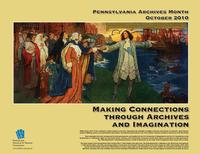October is National Archives Month! Many state archives have created posters like the one to the right to celebrate. And last week, you heard a little bit about our new archives project from Celia Caust-Ellenbogen, one of the archives assistants working in the Children’s Literature Research Collection (CLRC). But what exactly is all of the excitement about?
Many people have a mental image of an archives as a dusty, out-of-the-way place overflowing with stacks of musty paper and moldering volumes and presided over by a slightly forbidding and mysterious creature called an archivist. But what is an archives? And what does an archivist actually do? Like a library, an archives is a great place to go for information – specifically, firsthand information found in letters, diaries, artwork, photographs, audio recordings, and many other records that document the activities of individual lives and collective organizations. These records remain because someone has deemed them to be of enduring historical value. This is where the archivist comes in!
At cocktail parties, archivists often cheat and tell people they’re librarians because most people have an idea of what a librarian does, and it’s best to avoid an overlong explanation if your main goal in life is to make it to the table with the hors d’oeuvres before they’re all gone. But if we were trapped in an elevator, awaiting rescue by the fire department, and had some time on our hands, we would probably tell you that archivists collect, organize, preserve, and make available unique materials of lasting value. Most professional archivists have either a master’s degree in history or a master’s degree in library and information science, and some have both. Archivists must understand what the useful building blocks of history are, and they must be able to organize and preserve that information so researchers can use it.
You probably create your own archives at home, creating photo albums, saving letters, and preserving family records. You keep these materials because they are important to you, because they remind you of important events in your own life or in your family’s history. Professional archivists would take preservation measures to ensure that these materials wouldn’t rot away into nothingness, putting important documents in acid-free folders and acid-free boxes and storing them in temperature-controlled rooms. On Thursday, October 21st, as part of Archives Month, conservators at the Smithsonian will be answering your questions about how to care for your own personal and family archives at home, live on their Facebook page. And while you're putting your own records in safe, acid-free boxes, we'll be doing the same in the CLRC with the papers of children's literature authors like Robert Lawson and Virginia Lee Burton. Happy Archives Month!
Until Archives Month comes around next year, stay tuned to hear more about the CLRC project on our Facebook page or follow us on Twitter.
Have a question for Free Library staff? Please submit it to our Ask a Librarian page and receive a response within two business days.

